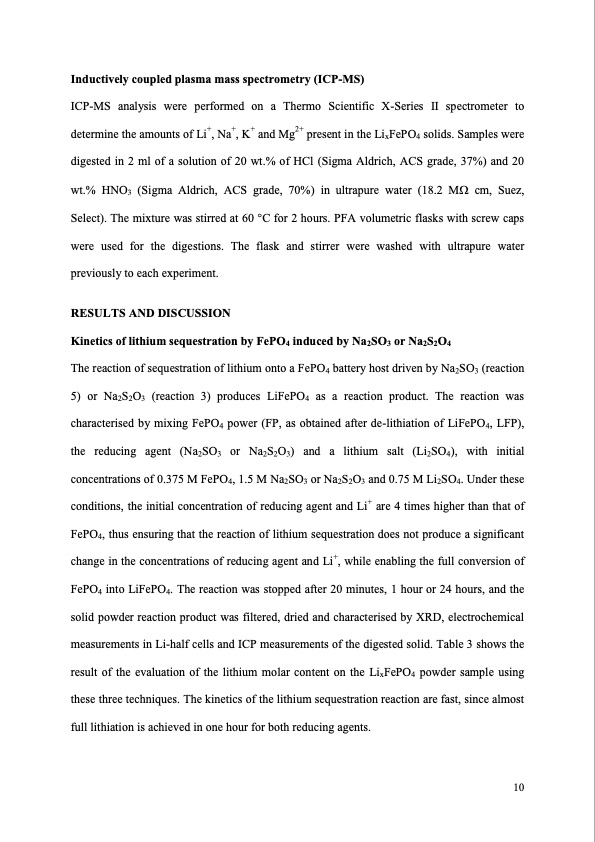
PDF Publication Title:
Text from PDF Page: 010
Inductively coupled plasma mass spectrometry (ICP-MS) ICP-MS analysis were performed on a Thermo Scientific X-Series II spectrometer to determine the amounts of Li+, Na+, K+ and Mg2+ present in the LixFePO4 solids. Samples were digested in 2 ml of a solution of 20 wt.% of HCl (Sigma Aldrich, ACS grade, 37%) and 20 wt.% HNO3 (Sigma Aldrich, ACS grade, 70%) in ultrapure water (18.2 M cm, Suez, Select). The mixture was stirred at 60 °C for 2 hours. PFA volumetric flasks with screw caps were used for the digestions. The flask and stirrer were washed with ultrapure water previously to each experiment. RESULTS AND DISCUSSION Kinetics of lithium sequestration by FePO4 induced by Na2SO3 or Na2S2O4 The reaction of sequestration of lithium onto a FePO4 battery host driven by Na2SO3 (reaction 5) or Na2S2O3 (reaction 3) produces LiFePO4 as a reaction product. The reaction was characterised by mixing FePO4 power (FP, as obtained after de-lithiation of LiFePO4, LFP), the reducing agent (Na2SO3 or Na2S2O3) and a lithium salt (Li2SO4), with initial concentrations of 0.375 M FePO4, 1.5 M Na2SO3 or Na2S2O3 and 0.75 M Li2SO4. Under these conditions, the initial concentration of reducing agent and Li+ are 4 times higher than that of FePO4, thus ensuring that the reaction of lithium sequestration does not produce a significant change in the concentrations of reducing agent and Li+, while enabling the full conversion of FePO4 into LiFePO4. The reaction was stopped after 20 minutes, 1 hour or 24 hours, and the solid powder reaction product was filtered, dried and characterised by XRD, electrochemical measurements in Li-half cells and ICP measurements of the digested solid. Table 3 shows the result of the evaluation of the lithium molar content on the LixFePO4 powder sample using these three techniques. The kinetics of the lithium sequestration reaction are fast, since almost full lithiation is achieved in one hour for both reducing agents. 10PDF Image | Novel method of lithium production from brines

PDF Search Title:
Novel method of lithium production from brinesOriginal File Name Searched:
MS_v9_ref.pdfDIY PDF Search: Google It | Yahoo | Bing
Product and Development Focus for Infinity Turbine
ORC Waste Heat Turbine and ORC System Build Plans: All turbine plans are $10,000 each. This allows you to build a system and then consider licensing for production after you have completed and tested a unit.Redox Flow Battery Technology: With the advent of the new USA tax credits for producing and selling batteries ($35/kW) we are focussing on a simple flow battery using shipping containers as the modular electrolyte storage units with tax credits up to $140,000 per system. Our main focus is on the salt battery. This battery can be used for both thermal and electrical storage applications. We call it the Cogeneration Battery or Cogen Battery. One project is converting salt (brine) based water conditioners to simultaneously produce power. In addition, there are many opportunities to extract Lithium from brine (salt lakes, groundwater, and producer water).Salt water or brine are huge sources for lithium. Most of the worlds lithium is acquired from a brine source. It's even in seawater in a low concentration. Brine is also a byproduct of huge powerplants, which can now use that as an electrolyte and a huge flow battery (which allows storage at the source).We welcome any business and equipment inquiries, as well as licensing our turbines for manufacturing.| CONTACT TEL: 608-238-6001 Email: greg@infinityturbine.com | RSS | AMP |